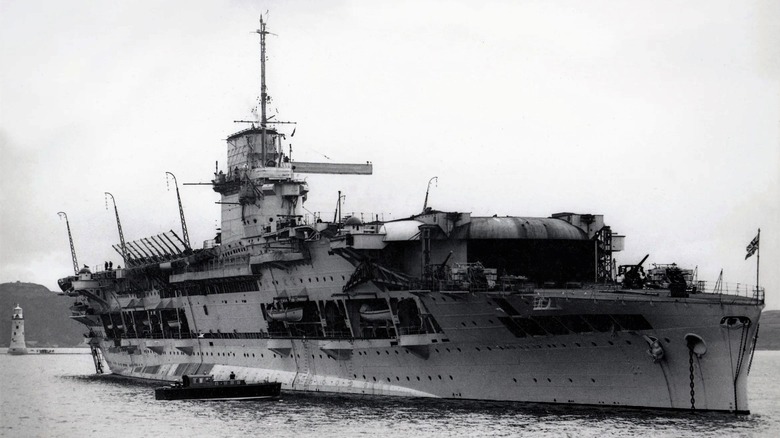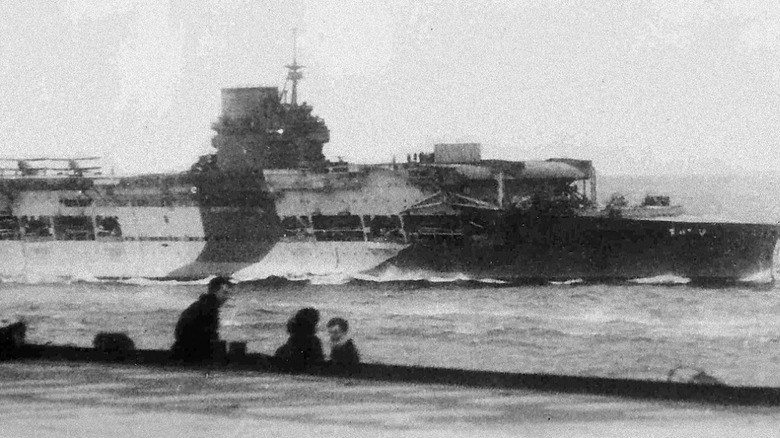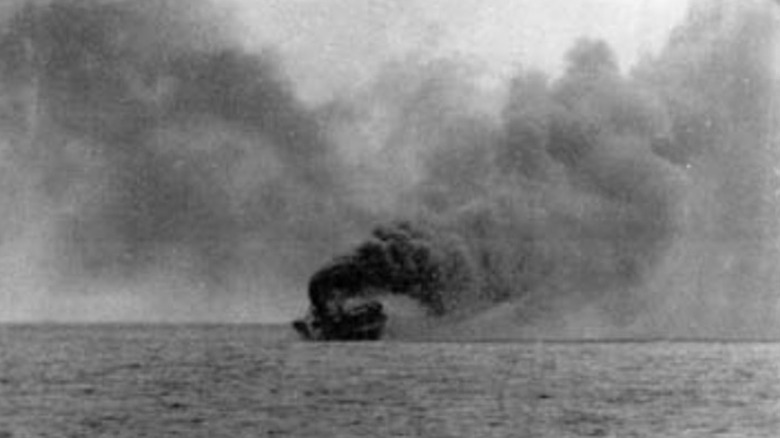The Intriguing Mystery Behind England's Lost WW2 Aircraft Carrier
On June 8, 1940, just four days after the evacuation of Dunkirk, the United Kingdom's Royal Navy suffered its worst loss of World War II when its HMS Glorious aircraft carrier and two destroyer escorts, the HMS Arden and HMS Acasta, were sunk by two German battlecruisers, the Scharnhorst and Gneisenau, as they sailed through Norwegian waters. With only forty-one survivors, the tragic loss killed 1,515 British and Maltese navy men, making it the bloodiest naval loss of the war for U.K. forces and one of the deadliest shipwrecks of WWII. Despite the tragedy's high profile, questions still surround the sinking some 85 years later, with politicians, historians, and military personnel doubting the Royal Navy's account of the incident.
Official accounts of the sinking state that the Glorious and its two escorts were spotted by German battleships while heading to the small British island of Scapa Flow to refuel. According to reports, adverse wind conditions prevented the Glorious from launching its aircraft, while the ships' boilers, having been shut down before the attack, were slow in reaching top speeds, stranding the warships in a firefight that left them on the bottom of the Arctic Ocean two hours later.
While some naval skirmishes, like the Battle of Midway, are infamous for sinking the most aircraft carriers, this story stands out in the history of aircraft carriers for its lack of clarity. Prime Minister Winston Churchill himself questioned the Royal Navy's explanation. For nearly a century, observers have pondered several questions this official account fails to answer: why did the Glorious separate from its convoy? Why didn't the aircraft carrier defend itself properly? And why could the three ships neither execute evasive maneuvers nor spot the German ships initially?
A naval mystery
Members of parliament have questioned the circumstances of the sinking since the summer it took place. Unfortunately for both the families of the deceased and the legislators looking for answers, the UK government's account of the accident leaves several questions unanswered. Officially, the United Kingdom states that the HMS Glorious broke off from its main convoy to refuel. But even British Prime Minister Winston Churchill is skeptical, noting in his memoir on the war, "This explanation is not convincing. The Glorious presumably had enough fuel to steam at the speed of the convoy." Furthermore, it does little to explain why the ship failed to execute basic reconnaissance measures, such as deploying its aircraft. In the 1970s, Captain Stephen Roskill, one of the Royal Navy's official historians covering WWII, determined that the party line was "bunkum," later noting that it "looks as though 1,515 men were killed partly as a result of a whole chain of Admiralty errors." On balance, the ship appeared suspiciously ill-prepared for a German attack, with official accounts giving little explanation as to why. As the then-First Sea Lord, Sir Dudley Pound, wrote in a 1940 Admiralty report, "Glorious seems to have forgotten that she was a Man o' War."
Theories abound
Several observers have tried to determine why the aircraft carrier broke from its convoy. One explanation is that political infighting between the ship's senior officers may have doomed the ship's command structure. Reports show that the HMS Glorious' commander, D'Oyly Hughes, prepared to court-martial both his lieutenant commander and his commander of air, which could explain why, in 1968, the commander of a destroyer in the Glorious' convoy wrote that the ship had signaled for permission to "proceed ahead to Scapa Flow for the purposes of making preparations for the impending courts martial." This explanation was supported by Captain Roskill, who put forth the theory in an article for the Sunday Times Review in 1980.
Some, however, find this explanation unsatisfactory, as it largely leaves the question of the Glorious' ill-preparedness up to negligence. Ben Barker, whose grandfather captained the HMS Ardent, proffers an alternative theory on the HMS Glorious' official website. According to Barker, the move was part of Operation Paul, a secret mission to block Swedish iron ore exports to Germany with air-dropped sea mines. Using official correspondence between Churchill, his naval staff, D'Oyly-Hughes, and members of the Royal Navy, Barker paints a compelling picture of a dangerous mission placing the HMS Glorious within range of German Luftwaffe and destroyers. Unfortunately, another emergency operation evacuated allied forces from Norway, stretching RAF resources and leaving the Glorious unprotected from German attack while it prepared its aircraft to execute mining missions in contested waters. Despite the prevalence of theories, the mystery remains. Although the Board of Enquiry has been released, it clears up little for historians who continue to investigate one of the greatest naval tragedies in British history.


